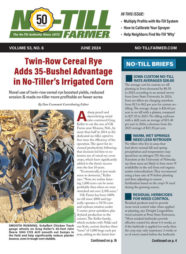Corn can face many different stresses capable of reducing stands, such as cold or wet soils, insect feeding, and unfavorable weather conditions. In severe cases of stand reduction, growers will need to determine if replanting will be more profitable than keeping the current crop.
Stand Evaluation
Stand counts. Step one in a replant decision is to determine how much the current corn stand has been reduced from the targeted stand. Reduced stands of healthy plants are easier to assess than stands of weak or injured plants. When an injury event such as frost or hail occurs it is best to wait a few days to perform a stand assessment, as it will allow a better determination of whether plants will actually recover or not.
To determine a plant stand for row crops, take several sample counts to represent the field or area under consideration. For ease of calculation, a sample size of 1/1000th of an acre is recommended (Table 1). Measure off the distance appropriate for your row width, count the number of live plants and multiply by 1000 to obtain a reasonable estimate of plants/acre.
Table 1. Row lengths equal to 1/1000th of an acre.
| Row Width | Length of Row |
| 38 inches | 13 feet 9 inches |
| 36 inches | 14 feet 6 inches |
| 30 inches | 17 feet 5 inches |
| 22 inches | 23 feet 9 inches |
| 20 inches | 26 feet 2 inches |
| 15 inches | 34 feet 10 inches |
Stand counts should be taken randomly across the entire area of the field being considered for replant; this may include the entire field or a limited area where damage occurred. The accuracy of your stand estimate will improve with the number of locations sampled within the damaged area.
Plant health. Once the plant stand has been determined, it is important to consider the health of the surviving plants. Plants that survive but are severely injured or defoliated will have reduced photosynthetic capability and a lower yield potential.
Stand uniformity. Consider whether surviving plants are evenly distributed in the field or if the stand is uneven, with frequent long gaps in the rows, An uneven stand will yield less than a relatively even stand with the same number of plants.
Yield Potential
Once the stand has been assessed, the expected yield from the current stand should be compared to expected replant yield. In general, that yield potential increases with increased stand up to the optimum of 35,000 plants/acre, and declines with planting dates later than April 20 and earlier than April 10. For example, a field planted April 30 with a final stand of 20,000 plants/acre would out-yield a final stand of 30,000 plants/acre planted on May 29.
Profitability of Replant
Even if replanting will increase yield, the yield increase must be sufficient to pay for all of the costs associated with replant such as:
- Extra herbicide or tillage costs (fuel, labor, equipment) to remove the old stand and prepare the new seedbed
- Planting costs (fuel, labor, seed, equipment)
- Increased grain drying costs
Also consider these factors when making a replant decision:
- Probability of an autumn freeze prior to physiological maturity of replanted corn
- Increased susceptibility of late-planted corn to summer drought or disease and insect pests such as gray leaf spot and European corn borer






Post a comment
Report Abusive Comment